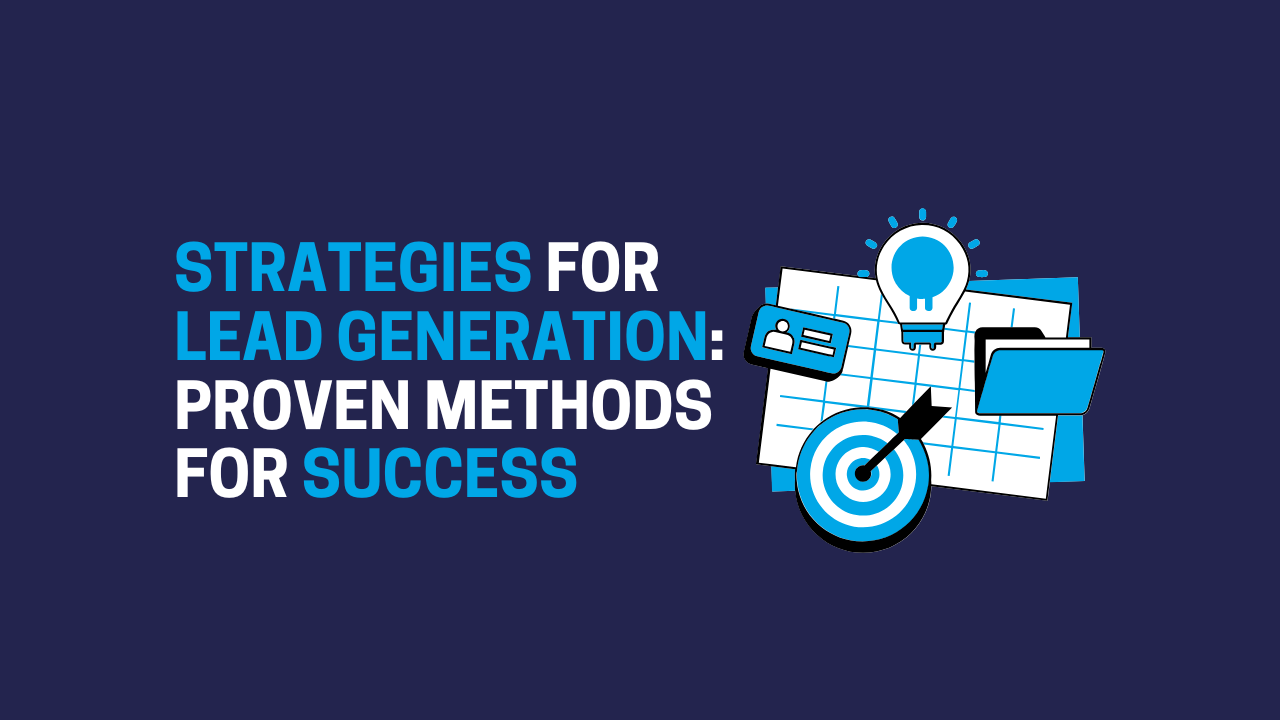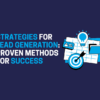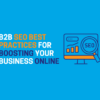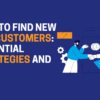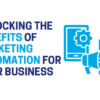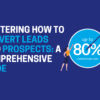Strategies for Lead Generation: Proven Methods for Success
Lead generation has long been considered the cornerstone of business-to-business (B2B) success. However, in these increasingly fast-paced times and hypercompetitive environment, outdated tactics no longer suffice. Businesses require strategies that are both effective and adaptable in today’s data-driven, digital sphere. Thankfully, proven lead generation methods exist that when combined with appropriate tools and trends can open up growth opportunities you never even imagined existed. This blog will walk you through cutting-edge strategies for lead generation for business, from taking advantage of social media to optimising marketing analytics. Filled with valuable insight from The Lead Generation Company’s expertise, it serves as your ultimate roadmap for building a robust pipeline with tangible results on how to get more leads.
1. Understanding the Modern B2B Lead Generation Landscape
What is Lead Generation in 2025?
In 2025, lead generation has evolved into both an art and a science. No longer merely casting a wide net and hoping for the best. Now lead generation involves precision targeting, nurturing relationships, and delivering value at every touchpoint. Businesses rely heavily on data analysis, automation, and personalisation techniques in order to identify prospects who align with their goals quickly before turning them into loyal customers efficiently.
The Difference Between Inbound and Outbound Lead Generation
Lead generation takes many forms. Inbound leads can come in via online channels while outbound methods must also be considered in terms of deployment strategy. Knowing when and how each should be used is the key.
- Inbound marketing aims to attract leads through content marketing, SEO and social channels, compelling prospects to engage at their own pace and build their trust over time.
- Outbound marketing entails proactive outreach such as cold calling or email campaigns directed directly towards buyers.
When combined, outbound and inbound tactics create an effective strategy where prospects are nurtured across multiple channels.
Quality vs. Quantity: Defining a Good Lead
Not all leads are created equal. Generating 1000 names on a list may be easy, but finding 50 decision-makers who genuinely have interest in your offering requires far more work. Modern lead generation prioritises quality over quantity by targeting prospects likely to convert. Ideal leads would include those that connect with your value proposition, match up well with ideal buyer persona profiles, and are ready to act immediately on them.
2. Top Strategies That Deliver Consistent B2B Leads
Outbound Calling and Email Outreach
Cold calling and email outreach has remained relevant due to its modernised methods. When combined with targeted email outreach campaigns, outbound efforts can gain incredible traction, particularly if underpinned with personalisation and compelling messaging.
LinkedIn and Social Selling
LinkedIn is the go-to platform for B2B lead generation strategies. Social selling goes beyond hard pitches or aggressive tactics. Instead it focuses on creating meaningful connections, building trust among decision-makers, and nurturing meaningful relationships between buyers and sellers. By participating in meaningful interactions, sharing relevant content, and contributing to industry conversations, professionals can establish themselves as reliable resources. This approach not only generates high-quality leads but also forms long-term business relationships that can bring sustainable growth over time. A strong presence on LinkedIn coupled with genuine interaction demonstrates better visibility and credibility, turning casual connections into potential clients or valuable partners.
Content Marketing Funnels and Lead Magnets
Quality content can do more than inform your target audience, it engages and converts too. Blogs, whitepapers and gated eBooks serve as powerful lead magnets in comprehensive marketing funnels. These resources create value right from the beginning by meeting key audience needs, building trust with target customers and establishing authority within your industry. Businesses that leverage such insights to attract and engage potential customers along their buying journey. Strategic content strategies provide businesses with a powerful way to stimulate interest and qualify leads, ultimately opening the way for further conversions. Engaging content draws users in by providing solutions for their challenges while subtly encouraging them to take the next step. Whether that means subscribing, signing up or making purchases. Businesses using content this way enhance their efforts to drive measurable growth.
Events, Webinars, and Thought Leadership
Digital events and webinars provide an ideal venue for brands to demonstrate their expertise while engaging receptively with an attentive audience. Virtual gatherings not only facilitate meaningful interactions but can also generate leads who are actively interested in your topic of choice. Thought leadership is very important in positioning your brand as an authority within its industry. By consistently offering valuable insights and innovative ideas, your business can build trust among prospects that are looking for solutions. Combining digital events and thought leadership into a cohesive strategy to attract, engage, and retain potential customers is sure to ensure they keep turning back to you for their needs.
3. Maximising the Impact of Your Lead Generation Efforts
Aligning Sales and Marketing Goals
Miscommunication between sales and marketing teams can seriously undermine your lead generation efforts. Both teams should collaborate by sharing goals and keeping in constant communication with one another. Collaboration ensures that potential leads are successfully nurtured without misalignment between these functions, thus creating a coherent buyer journey and experience. Cooperation among sales and marketing departments not only increases your lead conversion rates but also strengthens relationships with prospects throughout the customer journey, creating stronger bonds between salespeople and marketers that enable consistent customer experiences. Together they generate better results while maximising lead generation efforts’ impact.
Nurturing Leads Through the Funnel
Lead generation is only half of the equation and gathering email addresses only marks the start. To truly convert leads, nurturing through strategic approaches such as email drip campaigns provides consistent value while keeping leads engaged with your organisation. Retargeting ads play a big part in reminding potential customers about your offerings and maintaining their interest. Through tailored recommendations or exclusive content, personalised engagement helps build trust between brands and audiences and forms long-term relationships resulting in higher conversion rates down the funnel.
Personalisation and Segmentation for Higher Engagement
Modern B2B buyers require tailored communication that directly meets their needs. By segmenting audiences into identifiable personas, businesses can create highly tailored messages that reach deeper into an audience’s psyche and resonate more profoundly. This targeted approach not only grabs people’s attention but also creates stronger bonds, ultimately leading to enhanced engagement and higher conversion rates. With effective segmentation in place, companies are better equipped to tailor their messaging to specific pain points, goals and industries. Remaining competitive in an increasingly crowded marketplace (which should be one of your goals). Personalisation has become important to building trust among diverse customer groups while offering meaningful value propositions.
4. Essential Tools to Improve Lead Generation Efficiency
CRM Systems, Marketing Automation, and Data Enrichment Tools
A central CRM system such as HubSpot or Salesforce simplifies lead tracking while encouraging teamwork across teams, by consolidating customer data into one place. Automation tools further boost productivity by automating repetitive tasks such as email follow-ups or lead nurturing. Meanwhile, data enrichment tools play a huge role in keeping information accurate and up-to-date so you can make well-informed decisions and tailor approaches specifically to each lead. Having these tools for lead generation in your arsenal provides an ecosystem for managing leads, improving engagement and driving success within any competitive market.
Lead Scoring and Intent Data Platforms
Lead scoring is an important process that prioritises high-value prospects, enabling sales teams to focus on those most likely to convert. By assigning scores based on behaviours, demographics and engagement levels, scoring systems enable faster identification of top opportunities. Businesses benefit when combined with intent data, which reveals signals of purchase intent from prospective customers, to target purchase-ready leads more precisely and rapidly. The combination of lead scoring and intent data greatly improves the efficiency for the sales and marketing teams, enabling them to efficiently align efforts, personalise outreach, and drive higher conversion rates. Together they turn prospecting into an efficient results-driven process designed for growth.
AI-Powered Prospecting and Predictive Analytics
Artificial intelligence has revolutionised the prospecting processes and the future of B2B marketing by giving businesses powerful tools to increase efficiency and outcomes. Predictive analytics allow companies to anticipate the leads’ next moves, providing better timing and personalisation in outreach efforts. AI analysis of huge amounts of data highlights patterns that help refine these targeting strategies, which ultimately increases the success rates. AI-powered prospecting enables sales and marketing teams to make informed decisions, reduce guesswork, and focus their efforts on high-potential leads. Leading not only to increased conversions but also long-term growth and stronger customer relationships.
5. Leveraging Social Media for B2B Lead Generation
Using LinkedIn for Targeting Decision-Makers
LinkedIn offers unparalleled targeting capabilities for connecting you with key decision-makers. Marketers that are using its platform can leverage targeted ad campaigns and direct messaging with customised content for an impactful outreach strategy. Utilising LinkedIn’s powerful tools and audience insights, businesses can bypass the noise and directly target professionals that really matter. This strategic approach not only enhances engagement but also increases lead generation efficiency by building meaningful connections that drive growth. LinkedIn remains a phenomenal platform for B2B marketers looking to target and influence decision-makers effectively in an increasingly cluttered digital landscape.
Paid Social Ads vs. Organic Strategies
Balancing paid advertising with organic strategies is very important for your long-term business success. Paid ads on social media for B2B leads generation offer businesses quick and measurable results, helping businesses reach specific audiences efficiently. While organic efforts, like thought leadership posts or videos, can form long-term trust within an industry and build long-term authority within it. Paid ads create immediate visibility while organic strategies build credibility among their audience base. Together, both approaches work towards long-term success within this increasingly competitive digital landscape.
Employee Advocacy and Brand Presence
Encouraging your employees to advocate for your brand online can significantly extend its reach. When team members authentically share content online, this increases engagement and trust with any audiences. Employee advocacy shows a relatable and human side of your organisation while increasing audience loyalty, not to mention extending visibility further while creating an additional sense of connection with its followers. Giving employees access to tools and resources needed for advocacy helps build a unified front, reinforcing individual voices while simultaneously amplifying your digital footprint.
6. Content’s Role in Attracting and Converting Leads
Creating Tailored Content for Different Buyer Personas
Generic content cannot sustain a successful lead generation pipeline, so creating unique pieces tailored specifically for every stage of your buyer’s journey is absolutely necessary to creating leads. By providing targeted messages at specific moments in time and meeting specific needs and concerns head-on, deeper engagement and trust are built with audiences at every point from awareness through consideration to decision. By personalising this approach for each stage, you can not only strengthen these relationships but also significantly increase chances of converting the leads into loyal customers.
Blog Posts, Case Studies, Whitepapers, and Gated Resources
Engaging the buyer personas at all stages of the buyer journey with content forms such as blog posts and gated whitepapers is extremely important for creating value at every point in time along the buyer journey funnel. Blogs provide thought-provoking posts while gated whitepapers deliver detailed and in-depth knowledge that benefits leads at every stage.
How to Use Content to Guide Leads Through the Buyer Journey
Aligning content to each stage of a buyer’s decision-making process is important for lead nurturing. Educational blogs help build awareness early on while case studies establish credibility during the consideration phase. Each content type serves its own distinct function to move leads through the funnel and toward conversion. By taking this strategic approach to lead nurturing, this ensures potential customers receive tailored information at just the right time for meaningful decision-making processes and successful outcomes.
7. Using Analytics to Refine Your Lead Generation Strategy
Tracking Key Performance Metrics (CPL, MQLs, Conversion Rates)
Monitoring key performance indicators like cost-per-lead (CPL), marketing-qualified leads (MQLs), and conversion rates provides phenomenal insights into your campaign success. By keeping tabs on these KPIs regularly, marketers can evaluate the success of their efforts while optimising strategies for improved results. Businesses can identify areas for improvement and measure return on Investment (ROI). Regular analyses of these lead generation analytics ensure campaigns stay data driven and in alignment with goals, resulting in enhanced lead generation and conversion results over time.
A/B Testing Landing Pages and CTAs
Landing pages and calls-to-action (CTAs) are some of the best lead generation tactics in attracting leads for businesses. So A/B testing various designs and messages helps businesses determine which versions perform the best, so they can refine and optimise conversion rates over time. Through continuous testing and refinement, businesses ensure their landing pages and CTAs resonate with their target audiences and drive increased engagement leading to improved engagement levels and better results. An important strategy in meeting marketing goals effectively and remaining competitive.
Iterating Campaigns Based on Performance Data
Analytics not only facilitate but also enable iteration. Regularly reviewing the campaign performance allows marketers to identify underperforming tactics while amplifying successful strategies. This ensures continuous improvement and better results. Using data insights effectively also enables businesses to refine methods, adapt to changing trends, optimise future campaigns, stay competitively responsive to target audience preferences and needs, while simultaneously using iteration powered by analytics as a dynamic feedback loop for continuous improvement and increased revenue growth.
8. What’s Next? The Future of B2B Lead Generation
Predictive Lead Generation with AI and Machine Learning
AI-powered predictive technologies have revolutionised B2B lead generation. By analysing the data to analyse the buying behaviours, it identifies high-value leads and recommends optimal outreach strategies with remarkable precision. Businesses can streamline efforts, increase efficiency and connect with prospective prospects at just the right time. Saving them both time and efforts while optimising results to stay ahead in an evolving data-driven marketplace.
Hyper-Personalisation at Scale
AI and big data allow B2B marketers to produce highly tailored messages and content for their leads, using predictive analytics to understand each lead’s specific needs and pain points before crafting tailored messaging that resonates with them.
Privacy, Compliance, and Data-Driven Trust
As AI and big data use continues to increase, so too do concerns surrounding privacy and compliance. B2B marketers must prioritise protecting sensitive information while complying with regulations such as GDPR to maintain trust with their audience. Transparency is important when collecting and using data responsibly. By implementing robust compliance measures and ethical data practices, businesses can demonstrate their dedication to safeguarding their customer data while using it ethically for insights.
Conclusion
Lead generation is at the centre of any successful business strategy. By using effective lead-generating techniques such as cold-calling (telemarketing), content marketing, SEO optimisation, social media platforms and adhering to ethical data practices, businesses can attract, engage, convert and retain high-quality leads. Businesses must adapt strategies regularly in response to emerging technologies or changing consumer preferences while forging meaningful relationships based on trust and value for sustainable growth. Prioritising innovation, transparency, and being customer-centric can ensure long-term success of lead generation efforts.
At The Lead Generation Company, our award-winning telemarketing services integrate many of the strategies discussed throughout this blog—from personalised outreach and data-driven targeting to lead nurturing, segmentation, and real-time qualification. Our expert team doesn’t just make calls; we build meaningful conversations that drive results. Whether you’re looking to generate high-quality leads, enhance your outbound campaigns, or align sales and marketing for better conversions, our tailored telemarketing approach delivers measurable ROI. Get in touch today to see how we can help fuel your business growth with proven lead generation solutions that work.






